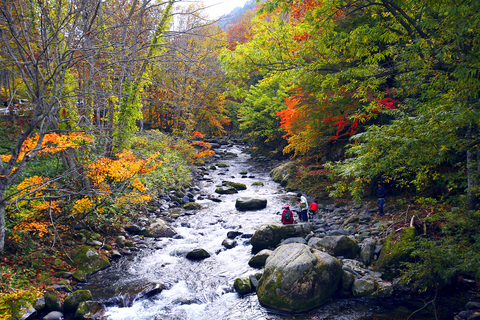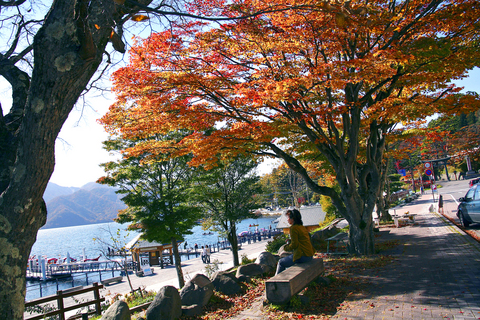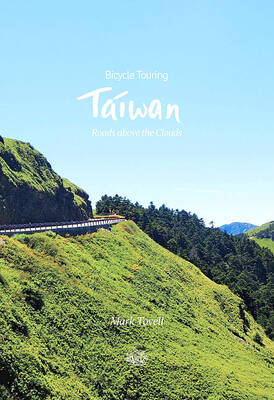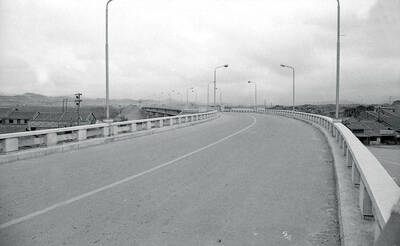Walk into any railway ticket office or travel agency in Japan these days, and there is a good chance it will be festooned with garlands of red paper leaves and plastered with enormous photographs of autumn landscapes, all exploding with color. Kouyou season is here.
Kouyou, which can be translated literally as "red leaves" or idiomatically as "changing colors," may be less well-known to international tourists, but it is as important to the Japanese as their fabled cherry blossom festival in the spring. It is a time of dazzling beauty, with streaks of red, orange, yellow and gold splashed across vast areas of the countryside. And it takes place during one of the best times to visit Japan, between the stifling humidity of the summer and the chill of winter.
"There are four distinct seasons in Japan," said Eiichi Ito, director of the Visit Japan Campaign secretariat, a tourism coordinating group. "We recommend spring and autumn, because the weather is very fine and the season is so beautiful."

PHOTOS: NY TIMES NEWS SERVICE
The season is longer, too. Though cherry trees can bloom and then lose their blossoms within the span of a week or less in the spring, the changing of the colors in fall occurs over more than two months across Japan. The earliest changes take place in late September at high altitudes, where temperatures are lower, and on the northern island of Hokkaido. But the colors are still on show in the south and west of the country in late November.
The most intense colors come out in areas where the temperature drops most suddenly, said Jin Murata, a professor and curator of the botanical gardens at the University of Tokyo. "If the change is slow, the color is not so beautiful," he said.
The most famous kouyou trees are probably the Japanese maple, whose leaves turn bright red, and the ginkgo — a Chinese import, as Murata pointed out — whose leaves turn yellow. But plenty of others put in an appearance: beeches, lacquer trees, and even those cherry trees, whose leaves can take on a fiery golden color.

Murata added that the longer season and range of color were because of the variety of trees in Japan, since different species react to the climate changes with different timing.
The changes don't happen at the same time in the same place every year, though, said Hiroko Ueno, assistant manager of the Tourist Information Center of the Japan National Tourist Organization in Tokyo. Last year, for example, higher temperatures pushed the kouyou later into October and November. But this year, she said, "I feel a little bit cooler."
Color changes typically take several days for a given tree, Murata said. A Japanese maple can take at least two weeks. So there is some leeway in planning a kouyou trip. Indeed, it's a good idea to get a head start on your sightseeing because the crowds can be enormous. The area called Qurankei, in Aichi prefecture, for example, is always popular. At the peak of the season there, cars and buses streaming toward the prime viewing sites can cause gridlock, especially on weekends.
If you're already in Japan during kouyou season, chances are you'll be near a good place to see some spectacular foliage. Ueno recommended a number of kouyou locations, from the top to the bottom of the country. They include the slopes of the Daisetsu volcano group on Hokkaido, in the north, which give a colorful showing relatively early in the season; and Kankakei Gorge, a valley on Shodoshima Island in Japan's Inland Sea, which turns flaming red and is visible from the island's cable cars. Well-known tourist destinations like Kyoto, Kamakura, Nara and Hakone also offer great kouyou possibilities, Ueno said. But if you're stuck in Tokyo on business, you still have plenty of options.
The city's parks offer a wide range of trees and colors. The Inokashira Koen, near the train station of the same name, was the first park opened to the public by an emperor, when Taisho (known as Yoshihito during his reign) founded it in 1917. The Hibiya Koen, which is closest to the Kasumigaseki subway station, is a Western-style park with a great variety of trees, many of which have leaves that change color in the fall.
Ueno suggested the Rikugien, a traditional Japanese garden on land that was given by a 17th-century emperor to one of the noblemen who supported him. It's near Komagome station in the north of the city. Closer to the center, a short walk from the Shinbashi station, with a somewhat incongruous background of skyscrapers, is the Hama-Rikyu garden, which once housed a villa for the imperial family. One of the most striking sights is Jingu Gaien Street, which leads from Aoyama to the Meiji Kaigakan art museum (also called the Memorial Picture Gallery) through a double line of ginkgos. The street is just off Aoyama Dori in central Tokyo, near the Gaienmae subway station and the Shinanomachi train station.
For the Japanese, enjoying the kouyou season is a fairly low-key pursuit. Ito said that people typically went on hikes with their families or with co-workers, perhaps stopping at restaurants with views of the foliage. (In Tokyo, there are cafes with views near most of the parks.) There are also some traditional autumn snacks, like goheimochi, clumps of pasty rice broiled on sticks that are popular around Qurankei. But there is not a full-blown festival.
That's partly because kouyou season lasts so long; there isn't the urgency to celebrate as there is in cherry blossom season, Ueno said. "In spring, we drink and eat and dance till late at night. In autumn, we quietly appreciate it."
FIERY FOLIAGE IN A QUIETER SEASON
You don't have to be in Japan to find out when the colors are changing. There are several resources just a click or a phone call away. The Japan National Tourist Organization maintains a Web site with general guidelines at www.jnto.go.jp/eng (click on seasonal attractions, then seasonal highlights). A slightly more comprehensive version is available in Japanese, at kouyou.nihon-kankou.or.jp/.
For the most up-to-the-minute information, you can call the Tourist Information Center of the Japan National Tourist Organization in Tokyo. Every day, the center updates its own list of kouyou sightings, with a five-point rating scale that ranges through "not yet," "starting," "half," "suitable" and "end."
"We are networked with over 140 local information offices," said Ueno. "Day by day, or one by one, we collect this information."
The center is on the 10th floor of the Tokyo Kotsu Kaikan building, just across from the Yurakucho subway station in Tokyo; 81-3-3201-3331. It is open from 9am to 5pm daily.
In addition to Daisetsu and Kankakei Gorge, Ueno recommends the following places for fall color:
Matsushima. This city on the northeastern coast of the main island of Honshu looks out onto a bay sprinkled with 260 little islands.
Nikko. It's less than two hours from Tokyo by train, but some of the peaks in this scenic mountainous area rise to 2,438m. As a result, the season starts quite a bit earlier than in the low-lying cities. The region is also known for its combination of natural and man-made beauty, Ueno said, with temples and shrines in stunning settings.
Tateyama. In Honshu's Japanese Alps you can trek through fall colors on a "grand scale," Ueno said, with remarkable vistas from what's called "the roof of Japan."
Kanazawa. On the northern coast of Honshu, this castle town has one of the country's three most famous landscape gardens.
Miyajima Island. Located near Hiroshima in the Inland Sea, Miyajima is known for its temples and for Mount Misen, a holy site that also gives quite a kouyou show.
Takachiho Gorge. On Kyushu, the southernmost of the large islands, the changing colors of the leaves are mixed with ravines and rushing waterfalls.

Last week, Viola Zhou published a marvelous deep dive into the culture clash between Taiwanese boss mentality and American labor practices at the Taiwan Semiconductor (TSMC) plant in Arizona in Rest of World. “The American engineers complained of rigid, counterproductive hierarchies at the company,” while the Taiwanese said American workers aren’t dedicated. The article is a delight, but what it is depicting is the clash between a work culture that offers employee autonomy and at least nods at work-life balance, and one that runs on hierarchical discipline enforced by chickenshit. And it runs on chickenshit because chickenshit is a cultural

My previous column Donovan’s Deep Dives: The powerful political force that vanished from the English press on April 23 began with three paragraphs of what would be to most English-language readers today incomprehensible gibberish, but are very typical descriptions of Democratic Progressive Party (DPP) internal politics in the local Chinese-language press. After a quiet period in the early 2010s, the English press stopped writing about the DPP factions, the factions changed and eventually local English-language journalists could not reintroduce the subject without a long explanation on the context that would not fit easily in a typical news article. That previous

It’s hard to know where to begin with Mark Tovell’s Taiwan: Roads Above the Clouds. Having published a travelogue myself, as well as having contributed to several guidebooks, at first glance Tovell’s book appears to inhabit a middle ground — the kind of hard-to-sell nowheresville publishers detest. Leaf through the pages and you’ll find them suffuse with the purple prose best associated with travel literature: “When the sun is low on a warm, clear morning, and with the heat already rising, we stand at the riverside bike path leading south from Sanxia’s old cobble streets.” Hardly the stuff of your

April 29 to May 5 One month before the Taipei-Keelung New Road (北基新路) was set to open, the news that US general Douglas MacArthur had died, reached Taiwan. The military leader saw Taiwan as an “unsinkable aircraft carrier” that was of huge strategic value to the US. He’d been a proponent of keeping it out of Chinese Communist Party (CCP) hands. Coupled with the fact that the US had funded more than 50 percent of the road’s construction costs, the authorities at the last minute renamed it the MacArthur Thruway (麥帥公路) for his “great contributions to the free world and deep